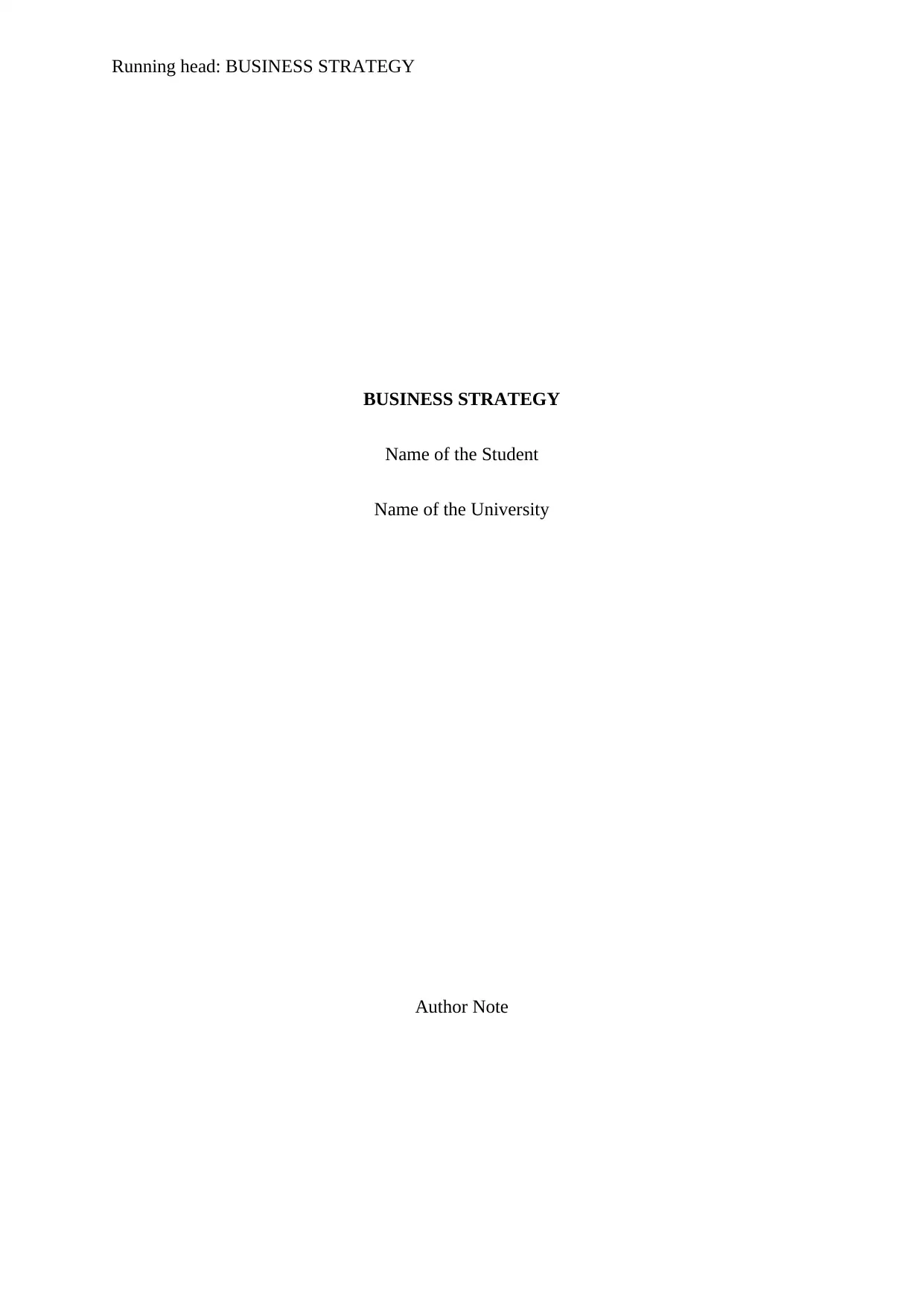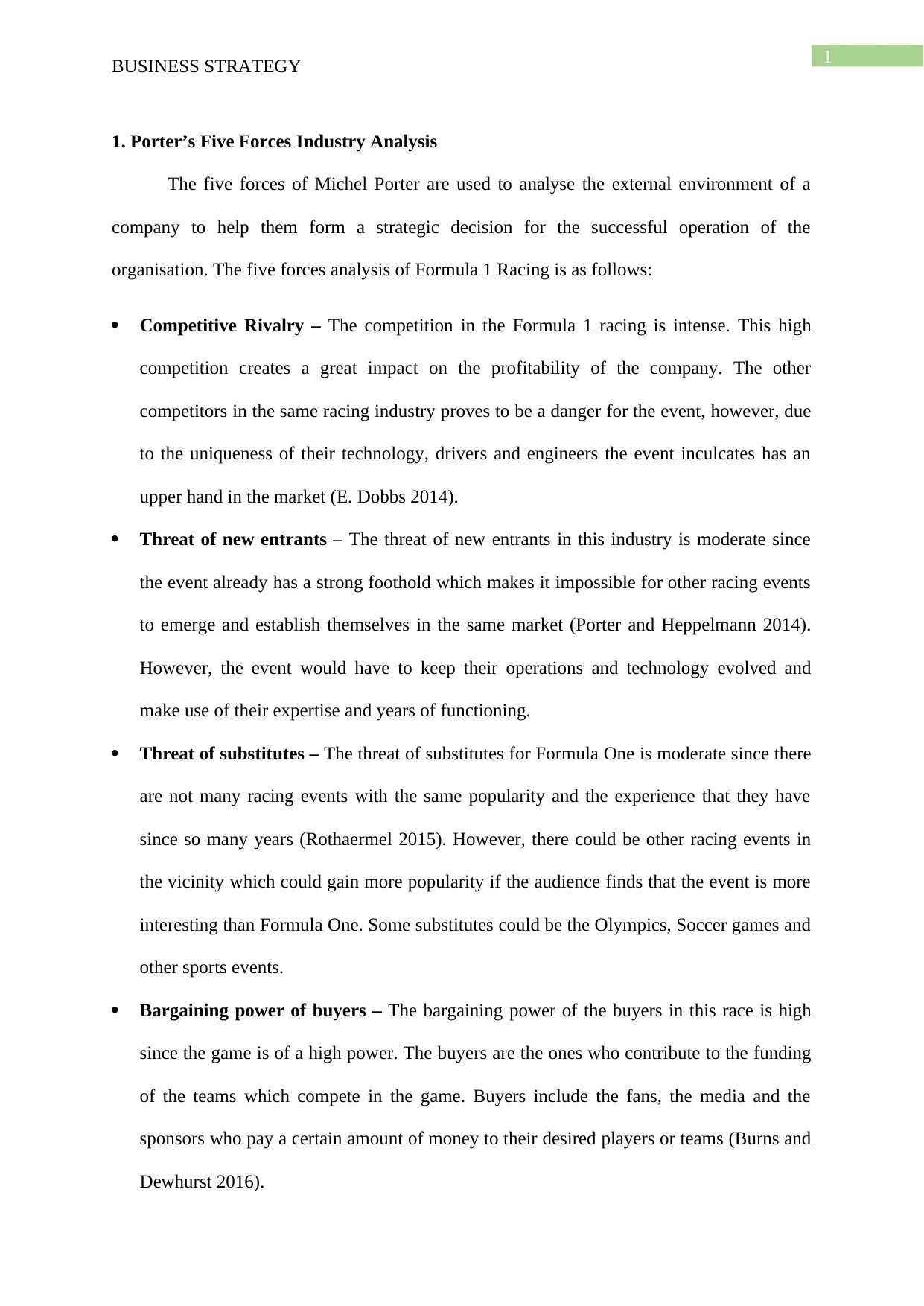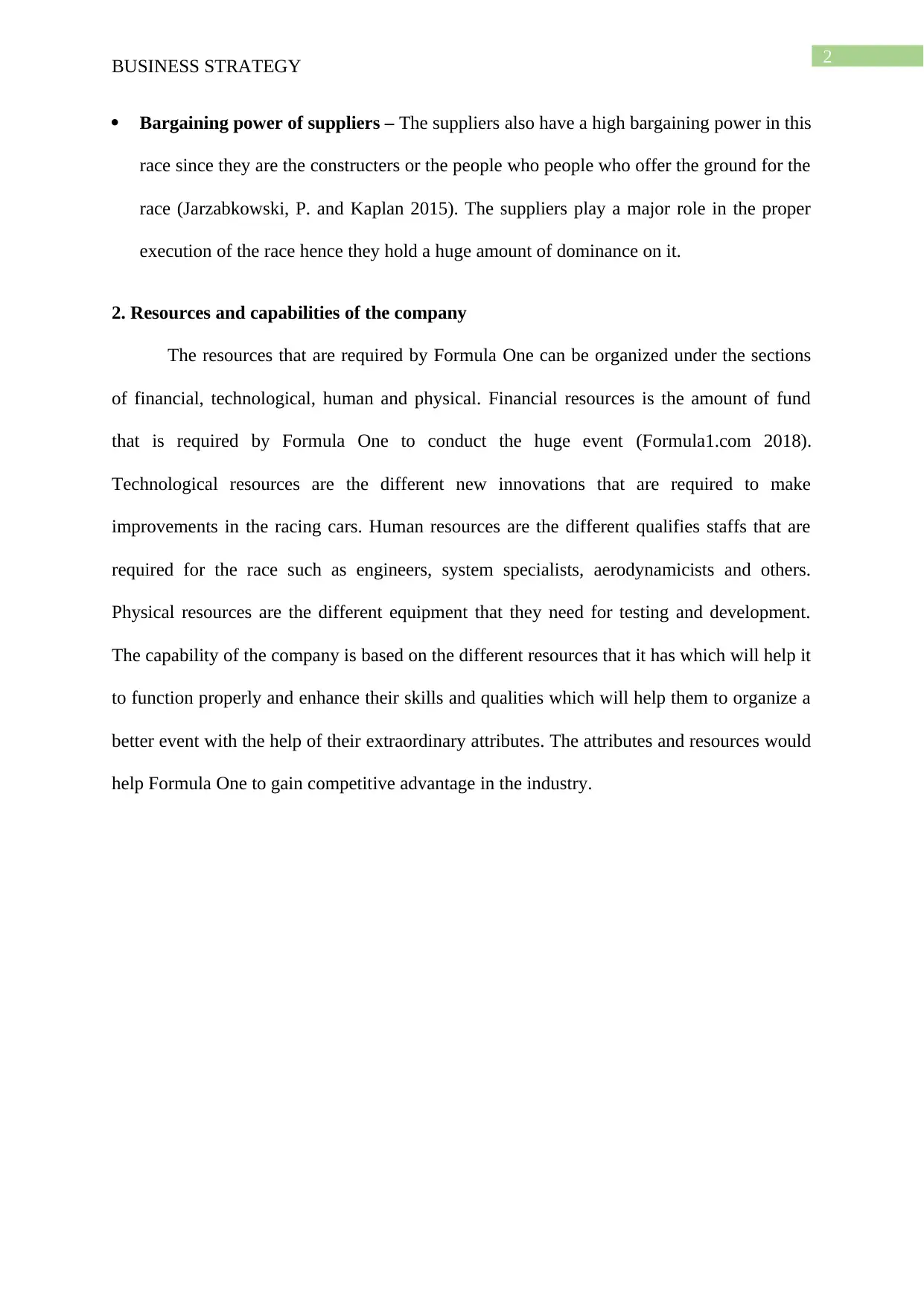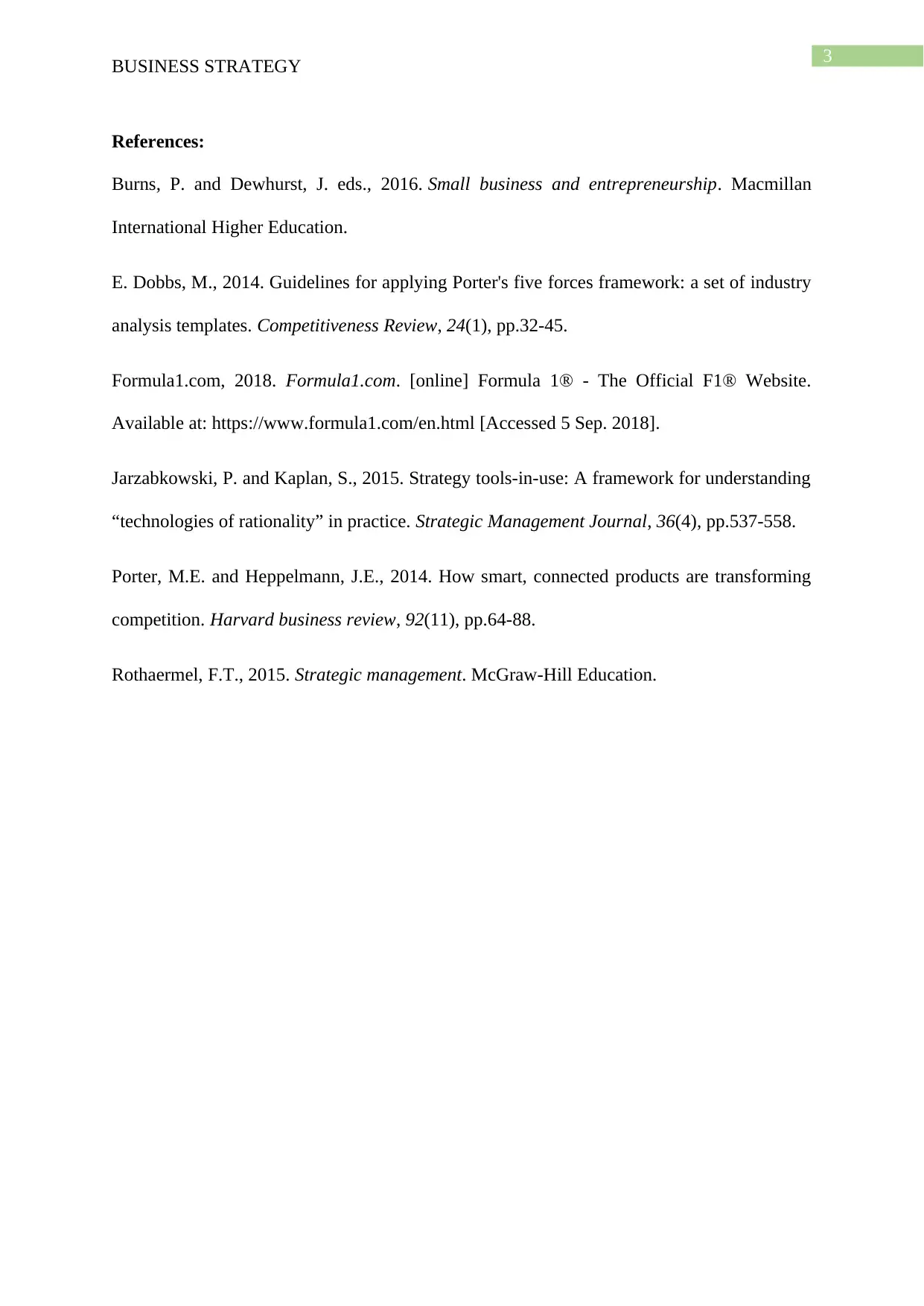Business Strategy: Applying Porter's Five Forces to Formula 1 Racing
VerifiedAdded on 2023/06/07
|4
|786
|81
Report
AI Summary
This report provides a strategic analysis of Formula 1 racing using Porter's Five Forces model. It examines the competitive rivalry, the threat of new entrants, the threat of substitutes, the bargaining power of buyers, and the bargaining power of suppliers within the Formula 1 industry. The report also discusses the resources and capabilities of Formula 1, categorizing them into financial, technological, human, and physical resources. It concludes that these resources and capabilities enable Formula 1 to gain a competitive advantage in the industry by enhancing their skills and qualities to organize a better event.

Running head: BUSINESS STRATEGY
BUSINESS STRATEGY
Name of the Student
Name of the University
Author Note
BUSINESS STRATEGY
Name of the Student
Name of the University
Author Note
Paraphrase This Document
Need a fresh take? Get an instant paraphrase of this document with our AI Paraphraser

1
BUSINESS STRATEGY
1. Porter’s Five Forces Industry Analysis
The five forces of Michel Porter are used to analyse the external environment of a
company to help them form a strategic decision for the successful operation of the
organisation. The five forces analysis of Formula 1 Racing is as follows:
Competitive Rivalry – The competition in the Formula 1 racing is intense. This high
competition creates a great impact on the profitability of the company. The other
competitors in the same racing industry proves to be a danger for the event, however, due
to the uniqueness of their technology, drivers and engineers the event inculcates has an
upper hand in the market (E. Dobbs 2014).
Threat of new entrants – The threat of new entrants in this industry is moderate since
the event already has a strong foothold which makes it impossible for other racing events
to emerge and establish themselves in the same market (Porter and Heppelmann 2014).
However, the event would have to keep their operations and technology evolved and
make use of their expertise and years of functioning.
Threat of substitutes – The threat of substitutes for Formula One is moderate since there
are not many racing events with the same popularity and the experience that they have
since so many years (Rothaermel 2015). However, there could be other racing events in
the vicinity which could gain more popularity if the audience finds that the event is more
interesting than Formula One. Some substitutes could be the Olympics, Soccer games and
other sports events.
Bargaining power of buyers – The bargaining power of the buyers in this race is high
since the game is of a high power. The buyers are the ones who contribute to the funding
of the teams which compete in the game. Buyers include the fans, the media and the
sponsors who pay a certain amount of money to their desired players or teams (Burns and
Dewhurst 2016).
BUSINESS STRATEGY
1. Porter’s Five Forces Industry Analysis
The five forces of Michel Porter are used to analyse the external environment of a
company to help them form a strategic decision for the successful operation of the
organisation. The five forces analysis of Formula 1 Racing is as follows:
Competitive Rivalry – The competition in the Formula 1 racing is intense. This high
competition creates a great impact on the profitability of the company. The other
competitors in the same racing industry proves to be a danger for the event, however, due
to the uniqueness of their technology, drivers and engineers the event inculcates has an
upper hand in the market (E. Dobbs 2014).
Threat of new entrants – The threat of new entrants in this industry is moderate since
the event already has a strong foothold which makes it impossible for other racing events
to emerge and establish themselves in the same market (Porter and Heppelmann 2014).
However, the event would have to keep their operations and technology evolved and
make use of their expertise and years of functioning.
Threat of substitutes – The threat of substitutes for Formula One is moderate since there
are not many racing events with the same popularity and the experience that they have
since so many years (Rothaermel 2015). However, there could be other racing events in
the vicinity which could gain more popularity if the audience finds that the event is more
interesting than Formula One. Some substitutes could be the Olympics, Soccer games and
other sports events.
Bargaining power of buyers – The bargaining power of the buyers in this race is high
since the game is of a high power. The buyers are the ones who contribute to the funding
of the teams which compete in the game. Buyers include the fans, the media and the
sponsors who pay a certain amount of money to their desired players or teams (Burns and
Dewhurst 2016).

2
BUSINESS STRATEGY
Bargaining power of suppliers – The suppliers also have a high bargaining power in this
race since they are the constructers or the people who people who offer the ground for the
race (Jarzabkowski, P. and Kaplan 2015). The suppliers play a major role in the proper
execution of the race hence they hold a huge amount of dominance on it.
2. Resources and capabilities of the company
The resources that are required by Formula One can be organized under the sections
of financial, technological, human and physical. Financial resources is the amount of fund
that is required by Formula One to conduct the huge event (Formula1.com 2018).
Technological resources are the different new innovations that are required to make
improvements in the racing cars. Human resources are the different qualifies staffs that are
required for the race such as engineers, system specialists, aerodynamicists and others.
Physical resources are the different equipment that they need for testing and development.
The capability of the company is based on the different resources that it has which will help it
to function properly and enhance their skills and qualities which will help them to organize a
better event with the help of their extraordinary attributes. The attributes and resources would
help Formula One to gain competitive advantage in the industry.
BUSINESS STRATEGY
Bargaining power of suppliers – The suppliers also have a high bargaining power in this
race since they are the constructers or the people who people who offer the ground for the
race (Jarzabkowski, P. and Kaplan 2015). The suppliers play a major role in the proper
execution of the race hence they hold a huge amount of dominance on it.
2. Resources and capabilities of the company
The resources that are required by Formula One can be organized under the sections
of financial, technological, human and physical. Financial resources is the amount of fund
that is required by Formula One to conduct the huge event (Formula1.com 2018).
Technological resources are the different new innovations that are required to make
improvements in the racing cars. Human resources are the different qualifies staffs that are
required for the race such as engineers, system specialists, aerodynamicists and others.
Physical resources are the different equipment that they need for testing and development.
The capability of the company is based on the different resources that it has which will help it
to function properly and enhance their skills and qualities which will help them to organize a
better event with the help of their extraordinary attributes. The attributes and resources would
help Formula One to gain competitive advantage in the industry.
⊘ This is a preview!⊘
Do you want full access?
Subscribe today to unlock all pages.

Trusted by 1+ million students worldwide

3
BUSINESS STRATEGY
References:
Burns, P. and Dewhurst, J. eds., 2016. Small business and entrepreneurship. Macmillan
International Higher Education.
E. Dobbs, M., 2014. Guidelines for applying Porter's five forces framework: a set of industry
analysis templates. Competitiveness Review, 24(1), pp.32-45.
Formula1.com, 2018. Formula1.com. [online] Formula 1® - The Official F1® Website.
Available at: https://www.formula1.com/en.html [Accessed 5 Sep. 2018].
Jarzabkowski, P. and Kaplan, S., 2015. Strategy tools‐in‐use: A framework for understanding
“technologies of rationality” in practice. Strategic Management Journal, 36(4), pp.537-558.
Porter, M.E. and Heppelmann, J.E., 2014. How smart, connected products are transforming
competition. Harvard business review, 92(11), pp.64-88.
Rothaermel, F.T., 2015. Strategic management. McGraw-Hill Education.
BUSINESS STRATEGY
References:
Burns, P. and Dewhurst, J. eds., 2016. Small business and entrepreneurship. Macmillan
International Higher Education.
E. Dobbs, M., 2014. Guidelines for applying Porter's five forces framework: a set of industry
analysis templates. Competitiveness Review, 24(1), pp.32-45.
Formula1.com, 2018. Formula1.com. [online] Formula 1® - The Official F1® Website.
Available at: https://www.formula1.com/en.html [Accessed 5 Sep. 2018].
Jarzabkowski, P. and Kaplan, S., 2015. Strategy tools‐in‐use: A framework for understanding
“technologies of rationality” in practice. Strategic Management Journal, 36(4), pp.537-558.
Porter, M.E. and Heppelmann, J.E., 2014. How smart, connected products are transforming
competition. Harvard business review, 92(11), pp.64-88.
Rothaermel, F.T., 2015. Strategic management. McGraw-Hill Education.
1 out of 4
Related Documents
Your All-in-One AI-Powered Toolkit for Academic Success.
+13062052269
info@desklib.com
Available 24*7 on WhatsApp / Email
![[object Object]](/_next/static/media/star-bottom.7253800d.svg)
Unlock your academic potential
Copyright © 2020–2025 A2Z Services. All Rights Reserved. Developed and managed by ZUCOL.





